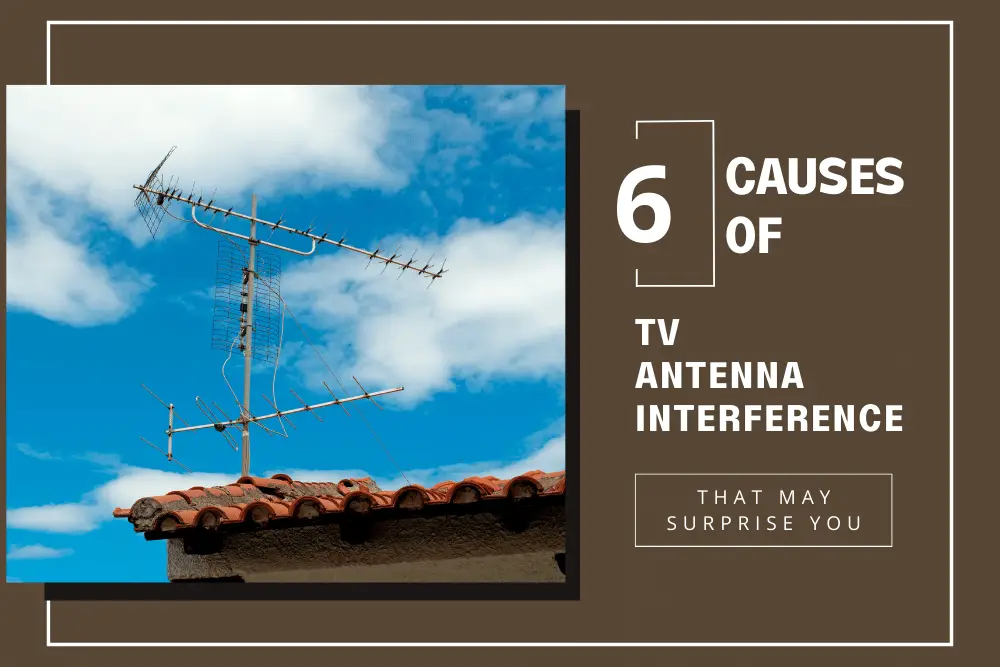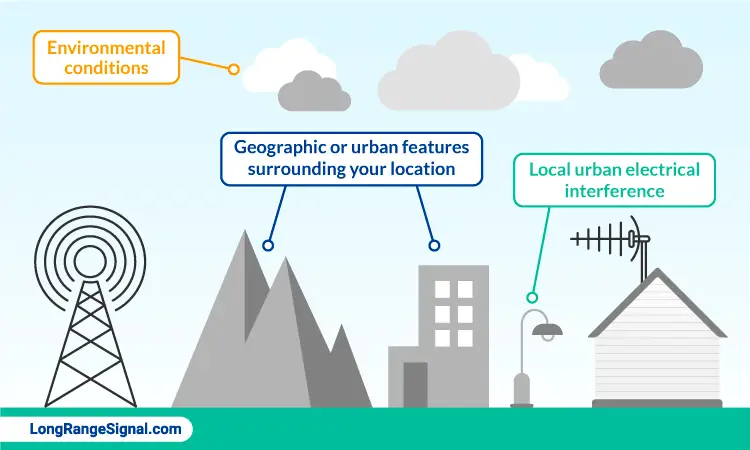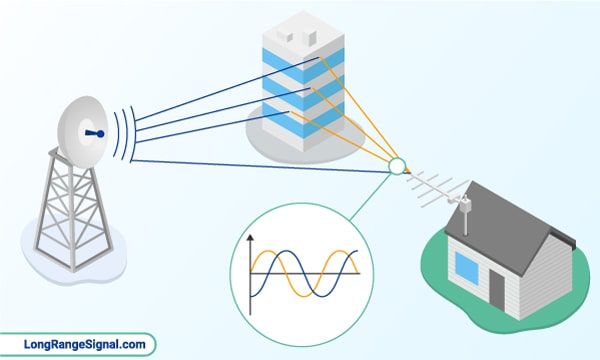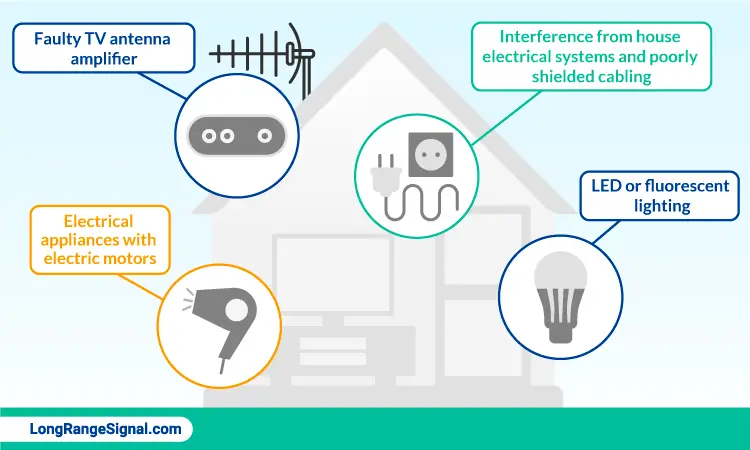
*As an Amazon Associate we may earn from qualifying purchases when you buy through links on our site.
If you notice your TV channels disappearing one day, only to return later, then you’ve experienced interference of over-the-air (OTA) TV signals.
Although interference manifests in only a few ways, like missing channels or a blank screen, the causes can be many. Broadly speaking, we can think about interference as originating from either outside or inside the home.
So what’s the cause of your TV channel fading out? Understanding what’s causing your missing channels can be challenging since there are typically few clues to go on.
How an Antenna Receives OTA Signals
Transmission towers broadcast TV signals as radio (i.e., radio frequency) waves. These waves are strongest when they leave the transmitter and gradually dissipate as they travel over the air.
It’s much like dropping a stone in a pool of water and watching the waves propagate outwards as a concentric ring whose ripple becomes gradually smaller.
A TV antenna features a set of metal dipoles whose sizes are proportional to the wavelengths of the radio signals they’re receiving. As a radio wave moves over an antenna, the antenna subtly vibrates according to the wave’s frequency and properties, converting the wave into an electric current for use by your television.
Both indoor and outdoor TV antennas work in exactly this way.
As mentioned, radio waves naturally dissipate over a distance but they can also lose strength due to interference.
For instance, geographic features like hills and forests scatter or otherwise disturb the propagation of radio waves that travel around them.
What is RF Interference?
Radio frequency interference is anything that degrades or disrupts your reception of over-the-air signals. This disruption could be the result of either:
- A physical feature or barrier degrading the strength of the radio wave (i.e., signal attenuation), or
- A competing source that propagates signals on the same frequency as another source (i.e., electromagnetic interference)
Below l give examples of both these types of RF interference, starting with those found outside your home.
Causes of TV Signal Disruption Outside Your Home
These types include geographic or artificial features in your environment that protrude into the path of TV signals, from mountains to tall buildings.
Competing signal sources like nearby cell phone towers can also affect your television reception, if these happen to be transmitting on a frequency near that of your local television broadcast.
Nearby street lights turning on in the evening have also been known to interfere with TV reception.

Multipath Interference
Barriers like glass buildings or bodies of water can scatter a TV signal into multiple signals by reflecting these away in different directions.
This type of interference is known as multipath interference since the smaller signals can take different paths away from the path of the original signal.
Some of these signals may nonetheless find their way to your TV antenna but arrive out of phase, creating weird effects with your reception like pixelation or ghosting (in the old days pre digital TV).

Atmospheric Interference
Normal weather won’t interfere with RF signals, nor will temperatures like heat or cold, or normal amounts of precipitation.
However, hot and cold days can occasionally produce high-pressure conditions that trap cold air between layers of warm air. Under the right conditions, this may cause radio signals to skip along the cold layer at much further distances than usual.
If these far-away signals propagate at the same frequency as your local TV broadcasts, this may interfere with your reception and cause pixelation or your signal to drop out.
Cell Phone Tower Interference
Nearby cellular phone towers aren’t supposed to cause interference, but since the upper range of UHF frequencies were allocated to cell phone companies back in 2009, there have been reported cases.
Someone even invented an LTE filter that you attach to your antenna coaxial cable to minimize interference from cell phone towers broadcasting at frequencies very close to your TV signal.
Causes of TV Signal Disruption Inside Your Home
Your home may host various forms of electromagnetic interference, like insufficiently shielded cabling and wiring, LED lighting systems, or faulty equipment such as amplifiers. Such items have been known to interfere with TV reception.
Also the very structure of your house or apartment building can make it challenging sometimes to find the right location for an indoor antenna.

Your Walls and Roof
While a house is built to retain energy and keep bad weather out, it also does a terribly good job of hindering incoming TV signals. That’s why indoor antennas are manufactured with built-in amplifiers for boosting signal to noise.
Depending on your home’s construction materials, your walls and roof can impede your reception up to 40-50%.
Attic spaces pose the same challenges, especially since they tend to be particularly well insulated. The shiny metallic surfaces of radiant barriers can even veto usage of a TV antenna in the attic.
Electromagnetic Interference
Any device in your home that runs on electricity will emit a subtle electromagnetic field. That’s fine in and of itself, but if you own an older home whose cabling and wiring feature insufficient shielding, use of these appliances may cause reception issues.
Electrical Appliances
A list of items that have reportedly caused TV channels to drop out when activated include:
- Cordless phones
- Microwave ovens
- LED lighting systems (especially low-quality fixtures using an RF driver component)
- Appliances with electric motors, like hair dryers
- Faulty TV antenna amplifiers
- Popcorn makers
The list above is only a small part of a larger set of items that could potentially interfere with your TV signal.
To confirm whether an appliance or device is causing interference, turn the item off and unplug it, then check your reception.
Proximity may be another potential interference factor. Placing an electrical device that’s faulty and “leaks” electromagnetic radiation near your TV antenna coaxial cable might produce RF interference sufficiently strong to adversely affect channels.
Coaxial Cable Shielding
The main types of coaxial cable in the TV antenna world are RG-59 and the newer version, RG-6.
Although older and sporting thinner insulation than its more modern counterpart, RG-59 is still commonly used. But RG-6 is better suited for TV signals because of both its thicker core (center conductor), which assures superior TV signal quality, and its better-protected sheath.
If you suspect signal interference from a source within your home, then I recommend upgrading your antenna coaxial cable.
Final Thoughts
While you may be fairly certain of when you’re experiencing RF interference, it can be challenging to diagnose the source of the problem.
Weather conditions can make your channels mysteriously disappear in the evening. Or, your screen may suddenly pixelate for no apparent reason.
But understanding the source of your TV signal interference will allow you to take measures to get your channels back in working order.
